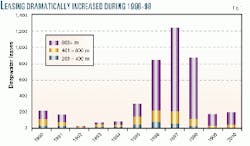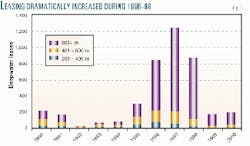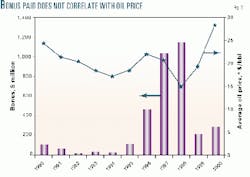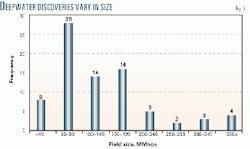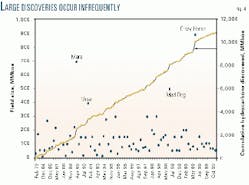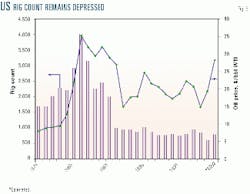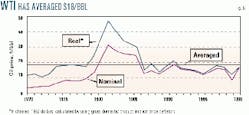Andrew B. DermanWithout the deepwater royalty relief program, the US risks suffocating its most promising oil and gas province at the very time it is struggling with what the nation's policy should be with regard to oil and gas.
Thompson & Knight LLP
DallasDaniel Johnston
Daniel Johnston & Co. Inc.
Hancock, NH
Our analysis indicates that if the royalty relief program is not extended, deepwater Gulf of Mexico economics might deter the industry from making the substantial investments required to develop this high-cost province with its highly sensitive risk-reward dynamics.
Royalty relief
The intent of the US deepwater royalty relief program was to stimulate exploration and development of deepwater Gulf of Mexico hydrocarbon resources. The program includes all Gulf of Mexico acreage offered between Nov. 28, 1995, and Nov. 28, 2000, in water depths 200 m or greater in the western and central planning areas and a small section of the eastern gulf.
Sale 175, in March 2000, was the final central lease sale automatically to benefit from the Deep Water Royalty Relief Act.1 The act grants deepwater leases limited royalty suspension based on equivalent barrels of oil produced, as follows:
- 17.5 million boe (MMboe) in 200-400 m.
- 52.5 MMboe in 400-800 m.
- 87.5 MMboe in water depths greater than 800 m.
The US Minerals Management Service (MMS) can grant similar royalty suspensions for leases issued prior to Nov. 28, 1995, if it determines that, without royalty suspension, a development project would be uneconomic. Moreover, the act clarified that MMS has authority to reduce or suspend royalty payments.1
Program's success
The program has been an unequivocal success.
After only 2 years, said Carolita Kallaur, former MMS acting director, "...Deepwater royalty relief for new leases has contributed to the record-breaking lease sales in the central and western Gulf of Mexico over the past 2 years, a clear signal that the Gulf of Mexico is now one of the world's leading oil and natural gas plays."2
More recently, the MMS partly attributed the large increase in bidding activity from 1996 to 1998 to the act.3 Fig. 1 illustrates the dramatic increase in deepwater leasing from 1990 to 2000.
Former Sen. Bennett Johnston (D-La.), author of the Deep Water Royalty Relief Act, when asked about the act, stated, "It is a good example of how the government needs to create opportunities for the forces of the market to work. This legislation allowed us to advance the exploration and production in the Gulf by years over what would have happened without it. We have [been able] to keep this country competitive with other energy producing countries ellipse by providing incentives to the companies who risked their capital."
The "American public [gets] cheaper domestic energy, while the oil and gas industry will contribute additional bonus, rental, royalty, and tax payments, as a consequence of the act." The law "should be perpetuated," Sen. Johnston said.
Rarely has a government program been so effective in attaining its objectives. Not only has the deepwater relief program stimulated additional exploratory activity, but it also will increase oil and gas production as well as royalty, tax, and bonus payments.
Under the 5-year royalty relief program, MMS has collected more than $3 billion in deepwater lease bonuses.4 And, as a consequence of the long cycle time from exploration to first oil, the bonuses are particularly meaningful in an economic analysis. They generate an immediate financial benefit to government and counter the argument that royalty relief is an industry windfall that denies the government future royalty payments.
Through the bonuses collected, the US has obtained competitive prices for its Gulf of Mexico deepwater acreage.5 In addition, the industry's enthusiasm toward the deepwater gulf has allowed MMS to increase the minimum bid to $37.50/acre from $25/acre. Rental payments have also increased, to $7.50/acre from $5/acre, in water deeper than 800 m.
Moreover, additional tax revenue will be received from projects that but for royalty relief would not have been developed.
US employment
Beyond the bonuses, royalty relief has stimulated billions of investment dollars in the search for oil and gas in the US. During 1998-2005, an estimated $9.5 billion will have been spent in drilling alone in the deepwater Gulf of Mexico.6
This activity has preserved and created US employment in an industry that is rapidly consolidating and focusing on projects outside the US.
Employment in the US oil and gas extractive sector has fallen precipitously.6 During 1982-99, it declined by more than 50%, from more than 750,000 jobs to fewer than 300,000. In an 18-month period, from October 1997 to April 1999, employment fell from about 340,000 jobs to fewer than 285,000. During this same 18-month period, upstream industry employment in Texas fell from about 162,500 jobs to 144,000.7
While the new economy is attracting many new graduates, the oil and gas industry is rapidly consolidating and losing jobs. At some point, the US may become critically short of oil and gas expertise. Is it important to maintain oil and gas expertise in the US, because there is uncertainty about whether this expertise can be imported when needed.
The upstream oil and gas industry employs sophisticated technologies, relies on a multidisciplinary approach, manages substantial risk, is capital-intensive, and has long lead times, especially in deepwater environments. Can a "just-in-time" approach to filling employment needs work when the industry again looks to recruit highly skilled personnel?
Energy security
The recent oil price increases have highlighted energy-related issues that have remained dormant for nearly a decade.
Royalty relief has contributed to US energy security in the face of rising dependence on imported oil. Imports now represent nearly 57% of US oil consumption. The US Energy Information Administration (EIA) has predicted that, by 2020, the US will import 70% of its oil.8 Without deepwater Gulf of Mexico production, the US is even more dependent on foreign oil.
MMS has predicted that, before yearend 2000, gulf deepwater oil production will surpass shallow-water oil production. By yearend 2004, deepwater fields may produce as much as 65% of the US oil and 32% of the US gas produced offshore.9
Relief extension
The MMS is now considering whether to recommend renewing the royalty relief program or instituting a similar program that would continue to stimulate investment activity.
Some might suggest that it is not the royalty relief program that precipitated such substantial activity but rather the oil price increase. It is interesting to note that while the oil price increased in 1996 and 1997 and then fell in 1998, there appears to be no direct correlation between oil prices and deepwater leasing activity, at least in the short term.
Fig. 2 depicts this absence of correlation between oil price and deepwater bonus payments during the 6-year period immediately prior to initiation of the deepwater royalty relief program.
One should note that, under the act, royalty suspension ends and royalty payments are due when, on an annual basis, oil prices exceed $25/bbl or when gas prices exceed $3.50/MMbtu.10
The program's expiration is coming at a time when the oil and gas industry is managing its affairs conservatively and tentatively. Worldwide upstream investments fell markedly in 1999. Geophysical operations decreased by 20%, drilling decreased by 25%, and offshore construction decreased by 30-45%.11 No doubt, higher oil prices will stimulate additional spending in 2000, but a sober, even somber, attitude prevails in the oil and gas business.
Should the MMS be concerned that it will "kill the golden goose" if it fails to replace the deepwater royalty relief program? Oil and gas operations, especially deepwater operations, cannot be turned on and off easily.
If the MMS fails to renew or replace the deepwater royalty relief program, it may bring a premature end to some great oil and gas plays.
Industry and the MMS today are engaged in a dialogue over whether to perpetuate deepwater royalty relief. Is the program a critical ingredient to maintain oil and gas momentum in the deepwater Gulf of Mexico? Or is the program a windfall to industry? If so, should the program be scaled back to rebalance the economic equilibrium in favor of the US government?
Super-majors armed with the sophisticated technology have led deepwater Gulf of Mexico exploration. Majors and larger independents have followed closely behind, and smaller independents are beginning to enter the area.
As of February 2000, 65 companies held leases in the deepwater gulf, with 51 companies-28 of them operators-participating in drilling deepwater wells in the Gulf of Mexico. Nineteen companies had established production in waters deeper than 1,500 ft at that time, and 36 had either established production or were in the planning stages of development.
BP Amoco PLC and Shell Exploration & Production Co. entered the deepwater Gulf of Mexico early, before the royalty relief program, and they have made some large discoveries. But the field-size distribution has not demonstrated that industry can support its program economics in the deepwater Gulf of Mexico.
Deepwater was once the nearly exclusive province of the super-majors. And if the royalty relief program is not extended, will it again be the near exclusive province of the super-majors?
The oil and gas industry has historically seen clear benefits to having smaller companies follow the majors. The oil and gas upstream industry has allowed smaller companies to focus on the smaller projects and assume operations that could not withstand the overhead costs of the majors. This dynamic has allowed infrastructures to be built, followed by the more complete exploitation of a basin or region.
Elimination of the royalty relief may well jeopardize this dynamic. Without the economic incentive of royalty relief, will smaller independents enter the deepwater?
Field development
The deepwater Gulf of Mexico will yield a small number of oil and gas fields that are sufficiently large to justify exploration and development without royalty relief.
Participation in a play where exploration wells routinely cost $25 million or more and production facilities exceed $500 million requires deep pockets and sufficiently extensive exploration programs to offer companies the statistical chance of finding enough oil and gas to make a field development economic.
Historically, one out of three or four deepwater Gulf of Mexico exploration wells has been a technical success. The industry has drilled more than 230 deepwater wells in the Gulf of Mexico with about a 33% success rate. The oil and gas found, however, must shoulder the costs of extensive seismic and lease bonuses, to say nothing of multiple expensive wells and production facilities that challenge the budgets of even the largest companies.
Deepwater success rates related to larger fields are much lower and have been suggested to be no greater than 10%.12
Ten, or about 15%, of the 74 deepwater discoveries have recoverable reserves in excess of 250 MMboe. And because only one out of three wells is a technical success, only about 5%, of the wells have found more than 250 MMboe. Of these 74 fields, more than half, or 44 fields, have found less than 150 MMboe and 43% have found less than 100 MMboe.
Relatively few deepwater leases are producing, and while deepwater provinces are notorious for large exploration field size requirements, there have been relatively few large discoveries.
The median field size for deepwater Gulf of Mexico is 143 MMboe. While a 143 MMboe prospect may be an appropriate industry exploration target in some circumstances, such fields are rarely economically robust in a deepwater province and even less likely to support a company's exploration program economics. Fig. 3 illustrates field-size distribution.
It would be unrealistic to predicate any resource-management policy or investment strategy on field sizes larger than 125-150 MMboe.
The Gulf of Mexico is one of the three major deepwater provinces. The other two are off West Africa and Brazil. Aggressive testing of isolated prospects as small as 100 MMboe in the other deepwater provinces, however, is unlikely.
In fact, threshold field size for stand-alone grassroots development, as opposed to exploration, is very close to 100 MMboe in the Gulf of Mexico. And like most deepwater environments, virtually every development in these early stages is stand-alone.
Beyond the relatively small field sizes of the Gulf of Mexico, another aspect that characterizes the province is that its stratigraphy is proving to be more complex than originally thought. Field development requires more wells than originally planned.
Concern has been expressed over Shell's deepwater Mensa field and the possibility that unanticipated reservoir compartmentalization may constrain well productivity levels. A similar phenomenon has been observed in the Genesis field.
The deepwater Gulf of Mexico is known for high well production rates, on the order of 8,000-12,000 bo/d. But having to drill additional wells that cost in excess of $25 million/well results in a significant economic impact.
There are two clear phases in offshore basin development, as follows:
- The first phase is where we stand today, where large fields are required to justify the enormous infrastructure investment.
- The second phase occurs when there is sufficient existing infrastructure to justify the development of smaller fields.
Elimination of the deepwater royalty relief program may both cripple the first phase and, as a consequence, prematurely choke off the second.
Without sufficient incentive to explore for and develop deepwater oil and gas, the industry will not install the requisite infrastructure. And, without infrastructure, there will be little incentive for companies to explore for anything but giant fields.
The linkage between the two phases is not likely to proceed in a predictable and progressive manner. In the near term, most deepwater developments will have to be stand-alone. This is partly because of the typically shorter life cycle of a deepwater project where production to reserve ratios are about 20%, and partly because of distances and the fact that many deepwater production facilities will be mobile.13
Gulf of Mexico deepwater plays cover an enormous area and it will take many years and many billions of dollars to develop a sufficiently extensive infrastructure to fully develop the area.
A smaller notional field size should be expected because discovery size typically decreases over time. The better identifiable larger structures usually are drilled during the early exploration phase of an area.
Typically, 70-80% of the reserves in a basin are contained in 20% of the fields. Furthermore, often the reserves of the 10 largest known fields represent 30-50% of the known reserves, and these larger fields usually are discovered within the first decade of exploration. Because of technical challenges, the typical exploration cycle may be somewhat different in deep water, but it will follow this pattern (Fig. 4).
With the exception of the deepwater Gulf of Mexico and areas that have been declared off-limits, the US is an extremely mature oil and gas province. Upstream investment in North America dramatically decreased from 1998 to 1999 by about 27%.14
This situation is exacerbated when one considers the global movement away from exploration and into development of proven oil and gas. Even with the increase in exploration in the deepwater Gulf of Mexico, the US rig count hit 50-year lows in 1999 and remains depressed (Fig. 5).
Economics
Deepwater discoveries obviously must be large enough to justify expensive development programs. Exploration prospects, however, must be even larger to justify the harsh risks associated with such high exploration costs, not to mention associated costs.
The difference between technical success and commercial success is the field size threshold for development. Technical success occurs when a discovery is made. Commercial success for an exploration well occurs when it discovers sufficient hydrocarbons for a development program.
A commercial discovery, however, does not indicate true commercial success for an exploration program typically characterized by dry holes and noncommercial discoveries.
One significant problem in deepwater Gulf of Mexico is that the field size threshold for development without royalty relief is close to what appears to be the median field size found to date. If industry can barely justify development of existing discoveries, then it will certainly be unable to justify further exploration.
Royalty relief reduces both exploration thresholds as well as development thresholds and increases commercial success ratios relative to technical success.
Our analysis of deepwater Gulf of Mexico reveals that anticipated success rates have not been as robust as expected. Few large discoveries have been made, and economic returns are disappointing.
The analysis supports the conclusion that even those companies that have been fortunate enough to establish production in the deepwater Gulf of Mexico have not been the beneficiaries of anything close to a windfall, but quite the opposite. Without the royalty relief program deepwater projects, especially in ultradeep water, have generally not yielded attractive returns.
Our analysis used public domain information to recreate an economic analysis that considers the exploration, development, and production costs that have been and will be incurred and the expected production profiles of producing and planned projects.
Oil prices historically have averaged $18/bbl for West Texas Intermediate (WTI) in real terms (Fig. 6), and therefore, our analysis uses an $18 WTI flat oil price, as adjusted for quality and transportation.
Even though deepwater Gulf of Mexico presents significant exploration and technical risk and enormous costs, one might still expect that, with royalty relief, those companies with production would experience returns in excess of 20%. This appears not to be the case.
In light of the significant capital costs associated with deepwater Gulf of Mexico projects, the average-sized project, 125-150 MMboe, in 5,000-6,000 ft may generate a 20-30% rate of return. But when this project is burdened with major costs related to seismic, lease bonuses, and dry holes on other leases, the program economics are disappointing.
While several companies, notably the early players such as BP Amoco and Shell, have experienced double-digit program returns, other companies with production have, at best, experienced only single-digit returns. Obviously, most companies in deepwater Gulf of Mexico have not yet started production.
Our economic analysis did not fully incorporate the entire cost of exploration because we were unable to access internal costs associated with overhead and acquisition and processing of geophysical and other exploration data. While these costs are relatively small when compared to drilling or development costs, they are additional up-front expenditures that were not included in the economic analysis.
Because these costs occur early in the life cycle and deepwater projects have long cycle times, these costs should not be ignored because they would further depress economic returns.
Our analysis demonstrates that deepwater Gulf of Mexico has not provided a windfall for those companies fortunate enough to have successful discoveries. Indeed, the reverse could be argued. This is a difficult province with its own particular boundary conditions and problems that must be carefully considered and reflected in the government's policy decisions.
References
- 1995 Deep Water Royalty Relief Act, 43 U.S.C. SS 1337(a)(3) (1996).
- The Energy Report, Pasha Publications Inc., Vol. 26, No. 3, Jan. 19, 1998.
- Gulf of Mexico OCS Daily Oil and Gas Production Rate Projections From 2000 to 2004, MMS, January 2000, p. 14.
- Derman, A.B., and Johnston, D., "Bonuses enhance upstream fiscal system analysis," OGJ Feb. 8, 1999, p. 51.
- "MMS Raising the Stakes on US Gulf Leases," Platt's Oilgram News, Sept. 10, 1999.
- "Oil Industry Fears Higher Lease Royalties," Houston Chronicle, May 5, 1998.
- Bureau of Labor Statistics, 1999.
- Annual Energy Outlook 1999, DOE/EIA-0383.
- Gulf of Mexico OCS Daily Oil and Gas Production Rate Projections From 2000 to 2004, MMS, January 2000, p. 17.
- 43 U.S.C. SS 1337(a)(3)(C) (v) and (vi) (1996).
- "Worldwide drilling activity shrank by 25% in 1999," OGJ, Mar. 20, 2000, p. 70.
- "Industry to MMS: Hands off US Gulf Rules," Platt's Oilgram News, July 1, 1998.
- "Deepwater Production Skyrocketing As Technology, Incentives Spur Growth," Gas Market Report, FERC, Oct. 29, 1999.
- "Growth rate in E&P investments slowed to 3% since 1998," OGJ, Mar. 13, 2000, p. 37.
The Authors
Andrew B. Derman is a senior partner with Thompson & Knight LLP in Dallas. He heads the firm's International Energy Practice group. He was formerly an executive with Oryx Energy Co.
Derman holds a BA from New York University and a JD from Temple University Law School and is board certified in Texas in the field of oil, gas, and mineral law.
Daniel Johnston is an independent consultant to the international petroleum industry. He has worked for a number of government-owned national oil companies, major oil companies, and independent companies. He has a BS in geology from Northern Arizona University, Flagstaff, and an MBA from the University of Texas at Austin.
